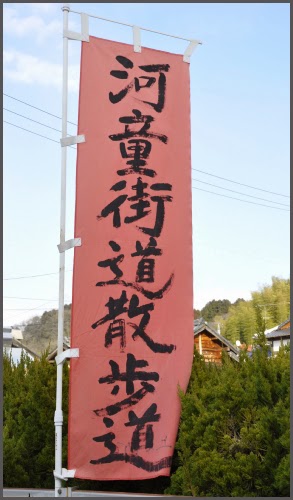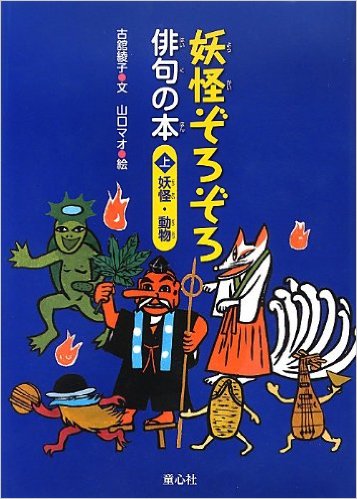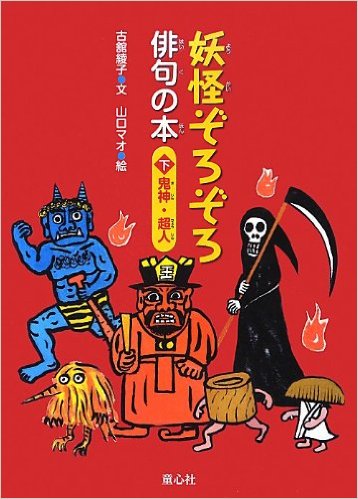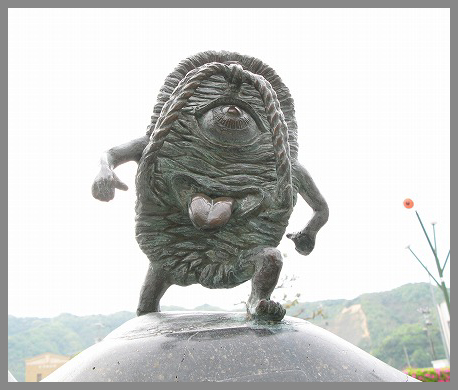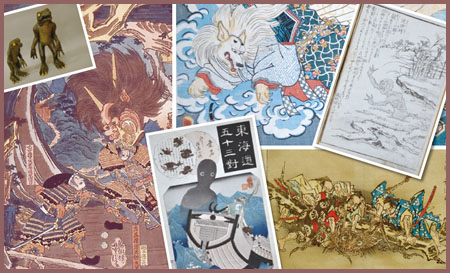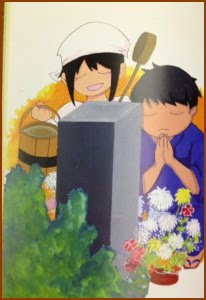- KAPPA - 河童 / かっぱ / カッパ - body parts -
:::::::::::::::::::::::::::::::::::::::::::::::::::::::::::::::::::::::::::::::::::::::::::::::::::::::::::::::::::::::::::::::::::::::::::::::::::::::::::::::::::::::::::::::::::
- sara 皿 plate with water on the Kappa's head -

- illustration modified from flamboyant . monster
The plate of a kappa is indented to hold a bit of water. Seldom there is a lid on the plate.
There must always be water in the plate for a kappa to be well and alive.
Just one or two drops of water are usually enough for a kappa to come back to live and reach the nearest river for more water.
..............................................................................................................................................
- quotes by Michael Dylan Foster
... Observing this child closely, they realize it is actually a kappa, and that there is water in the sara on its head. Accordingly, they shake their own heads; the kappa imitates them, spilling the water. Bereft of all strength, it is forced to leave.
. Sumo 相撲 wrestling and the Kappa .
. . . . . when it is weakened from losing water from its sara or incapacitated (emasculated) by a yanked-off arm, the honest and benevolent side of the kappa's nature surfaces.
. - benevolent Kappa 慈善河童 jizen no Kappa - .
..............................................................................................................................................
Once a Kappa slipped on some ogara hemp reeds, fell down and lost the water from his sara plate on his head. He soon lost all his power. ...
. A Kapa legend from Akita 秋田県 .
..............................................................................................................................................
. . . the Kappa at the temple Joken-Ji in Tono, Iwate
When a malicious Kappa tried to pull a horse into the water, he got caught by the farmers and had to promise to be good from now on. Then there was a fire at the temple and the Kappa rushed by, poured endless water from his plate on the head and extinguished the fire.
. Kappa komainu カッパ狛犬 / 河童狛犬 Kappa as Komainu .
..............................................................................................................................................
. Legends - Kappa densetsu 河童伝説 .
Kappa no Sara カッパの皿 The Dish of Kappa
豊岡村 Legend from Tomioka Village, Shizuoka
Once upon a time in the village of Tomioka there lived a Kappa at the どんぶち Donbuchi riverbank of the river Tenryugawa, but the Kappa was getting older. Yet he continued to play tricks on the villagers.
One day the farmer 為さん Tame san went for work to 三家村 Sankason village, about 4 km from his own village 伊折(豊岡村神田) Iori. He had to pass Donbuchi where he saw a young man waiting.
The young man said "Please hand this over!" and gave Tome san a letter.
The gentle Tome asked: "But to whom should I give it?"
The young man said:
"When you come to the village 壱貫地村 Ikkanji, turn right to the rifer and clap your hands. Then a young man will come and you can hand him the letter please."
. . . and disappeared suddenly.
Tame san walked on, maybe for about 100 meters, when a priest called him from behind.
"Hey wait, don't go today, better go tomorrow!"
But Tame san answered:
"But I promised to some one to deliver a letter, so I have to go today!"
"Well, show me that letter!" said the priest.
When Tame san pulled the letter out of his pocked and unfolded it, there was nothing written on it at all.

He thought this was strange and dipped the letter into the riverwater.
Now he could read it:
"This man looks quite delicious! Please eat him right away!"
Tame san and the priest began to shiver in shock.
Then the priest began some exorcism rituals for the letter in the field by the Eastern side of the river and gave it back to Tame san.
When Tame san finally reached Ikkanji, he turned to the river and clapped his hands.
As expected, a young man appeared and Tame san handed him the letter.
Well, the young man mad a surprised face and said "There must be something wrong!"
"No, no, I did as I was told" said Tame san and the young man shook his head mumbeling "Well, well . . . Oh, please wait a moment" and disappeared.
He was back in no time and said:
"This is the only plate I have. Take good care of it. Every day once in the morning and once again in the evening, you have to put it onto your head, strike it gently and make a wish. But never do this three times a day!" and disappeared again.
When Tame san had finished the work and was back at home, he wanted to try the new plate.
So he put it on his head, rubbed it and said: "I want some rice!"
And what do you say . . . there was rice flowing out of it, filling the floor of his small room to the brim.
Tame san was surprised, was happy, smiled, mumbled in surprise and soon became a famous elder of the village, who would always have rice to eat.
An old woman who lived close by stole this plate one day, when Tame san was out of the house. She put the plate on her head, rubbed it - and well - rice began to flow out of it.
She was quite happy and began to rub more and more - and well - the rice turned into sand.
A young man appeared:
"Promise this, old woman, never walk into the river in the month of August during the Bon festival for the ancestors! Not even after your death!"
Soon it was August and they found the dead body of the old woman on the Donbuchi riverbank. She had drowned in the river.
Soon there was rumor in the village:
"The Kappa has taken her Shirikodama out of the body and killed her!"
For many years the old Kappa had killed children and even grown-ups by the Donbuchi riverbank.
That is why the villagers always said:
"During the Bon month you should not walk into the river and not play in the river! The Kappa will get you and take your Shirikodama out.!
The End.
- source : www.chuen.net/mukashi
- - - - - This folktale is very similar to this one :
. Kappa ni moratta takaramono かっぱにもらった宝物 a treasure from the Kappa .
Ibaraki - 結城郡八千代町 Yuki-gun, Yachio-machi
:::::::::::::::::::::::::::::::::::::::::::::::::::::::::::::::::::::::::::::::::::::::::::::::::::::::::::::::::::::::::::::::::::::::::::::::::::::::::::::::::::::::::::::::::::

CLICK for more photos !
:::::::::::::::::::::::::::::::::::::::::::::::::::::::::::::::::::::::::::::::::::::::::::::::::::::::::::::::::::::::::::::::::::::::::::::::::::::::::::::::::::::::::::::::::::
- - - - - Haiku and Senryu - - - - -
五島高資 Goto Takashi
若水を頭にはこぶ河童かな
wakamizu o atama ni hakobu kappa kana
which means that Kappa is carrying a wakamizu on his head.
Wakamizu (we Japanese believe it the elixir of life) is the first water from a deep well or seawater we get early at dawn on the New Year's Day.
Only the water got before dawn on 1st January is believed as the nectar, and is called अमृत amrita.
- - - - - translated versions by Gabi Greve
a kappa
carries his water of life
on his head . . .
I often use . . . at the end to show there is KANA in Japanese.
Somehow I feel this should be in plural in English . .
.
all Kappa
carry the water of life
on their heads

New Year decoration to honor the Wakamizu - Deity of Water
. wakamizu 若水 "Young Water", first drawing of well water .
- - kigo for the New Year - -
..............................................................................................................................................

. Polite Kappa - よろしく yoroshiku .
..............................................................................................................................................
河童の皿濡らせるほどを喜雨とせり
kappa no sara nuraseru hodo no ki-u to seri
a beneficial rain
just enough to moisten
the plate of a kappa
上田五千石 Ueda Gosengoku (1933 - 1997)
. WKD : kiu, ki-u 喜雨 "beneficial rain" .
- - kigo for late Summer - -
..............................................................................................................................................
菱の実も河童の皿も乾くかな
hishi no mi mo kappa no sara mo kawaku kana
the water chestnuts
and also the plate of the Kappa
are all dried out . . .
中原道夫 Nakahara Michio
. WKD - hishi toru 菱取る collecting water chestnuts .
. . . . . hishitori 菱採り(ひしとり)
. . . . . hishi no mi toru 菱の実取るharvesting water chestnuts
- - kigo for late Autumn - -
..............................................................................................................................................
世も末か河童が皿を売りに出す
yo mo matsu ka kappa ga sara o uri ni dasu
has the world come to an end ?
the kappa goes out
to sell his plate
中年やまめ Chunen Yamame
..............................................................................................................................................
some kappa on a plate - literally
to hang on the wall

CLICK for more !


Click for more Kappa on plates and cups :
source : kappa hakubutsukan
..............................................................................................................................................
河童絵図藍濃き皿のふぐとかな
kappa ezu ai koki sara no fuguto kana
on the Kappa paintings
a fugu with dark
indigo colors . . .
西島麦南 Nishijima Bakunan (1895-1979)
(about a painting by Ogawa Usen 小川芋銭)
. Ogawa Usen 小川芋銭 (1868-1938) .

:::::::::::::::::::::::::::::::::::::::::::::::::::::::::::::::::::::::::::::::::::::::::::::::::::::::::::::::::::::::::::::::::::::::::::::::::::::::::::::::::::::::::::::::::::

. - - - Join my Kappa friends on facebook ! - - - .
:::::::::::::::::::::::::::::::::::::::::::::::::::::::::::::::::::::::::::::::::::::::::::::::::::::::::::::::::::::::::::::::::::::::::::::::::::::::::::::::::::::::::::::::::::
. Kappa densetsu 河童伝説, Kappa minwa 河童民話 - Legends - Introduction .
. Mingei 民芸 Regional Folk Art from Japan .
:::::::::::::::::::::::::::::::::::::::::::::::::::::::::::::::::::::::::::::::::::::::::::::::::::::::::::::::::::::::::::::::::::::::::::::::::::::::::::::::::::::::::::::::::::
[ . BACK to DARUMA MUSEUM TOP . ]
[ . BACK to WORLDKIGO . TOP . ]
- #kappasara - - - #sara -
:::::::::::::::::::::::::::::::::::::::::::::::::::::::::::::::::::::::::::::::::::::::::::::::::::::::::::::::::::::::::::::::::::::::::::::::::::::::::::::::::::::::::::::::::::





